Universal Pictures (also known as Universal Studios or Universal) is one of Hollywood's ‘Big Six’ films studios. In two posts we tell the story of Universal and its stars. Today, part 2. What happened with the studio after 1936, when Movie Mogul Carl Laemmle and his son had to leave Universal?

Deanna Durbin. Dutch postcard by Sparo (Gebr. Spanjersberg N.V., Rotterdam). Photo: Universal.

Maria Montez. Spanish postcard by Archivo Bermejo, Barcelona. Photo: Universal. Photo: publicity still for Sudan (John Rawlins, 1945).

Douglas Fairbanks Jr. American postcard by Universal. Photo: publicity still for The Exile (Max Ophüls, 1947).
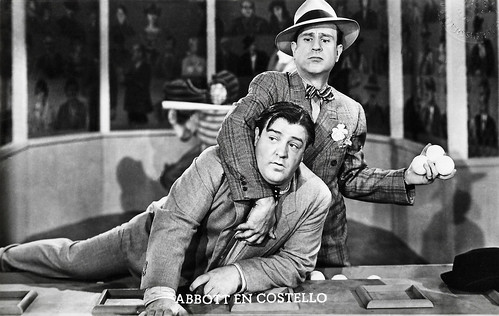
Bud Abbott & Lou Castello. Dutch postcard, no. 950. Photo: Universal Film.
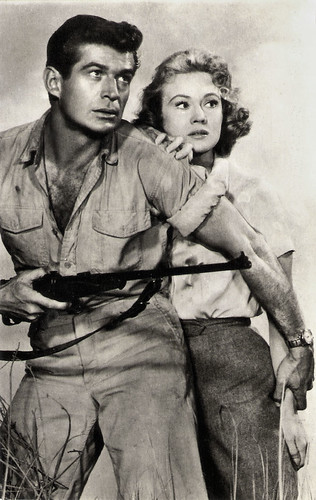
George Nader and Virginia Mayo. Spanish postcard by F.A.G., no. 440. Photo: Universal. Publicity still for Congo Crossing (Joseph Pevney, 1956).
Standard Capital's J. Cheever Cowdin had taken over as president and chairman of the board of directors, and instituted severe cuts in production budgets. Gone were the big ambitions, and though Universal had a few big names under contract, those it had been cultivating, like William Wyler and Margaret Sullavan, left.
Meanwhile, producer Joe Pasternak, who had been successfully producing light musicals with young sopranos for Universal's German subsidiary, repeated his formula in America. Teenage singer Deanna Durbin starred in Pasternak's first American film, Three Smart Girls (Henry Koster, 1936). The film was a box-office hit and reputedly resolved the studio's financial problems. It also began an eight-year era of successful Deanna Durbin musicals and spawned two sequels, Three Smart Girls Grow Up (Henry Koster, 1939) and Hers to Hold (Frank Ryan, 1943).
When Pasternak stopped producing Durbin's pictures, and she outgrew her screen persona and pursued more dramatic roles, the studio signed 13-year-old Gloria Jean for her own series of Pasternak musicals from 1939; she went on to star with Bing Crosby, and Donald O'Connor. Her best-known picture is her fourth, Never Give a Sucker an Even Break (Edward F. Cline, 1941), in which she co-starred with W. C. Fields.
A popular Universal film of the late 1930s was Destry Rides Again (George Marshall, 1939), starring James Stewart as Destry and Marlene Dietrich in her comeback role after leaving Paramount. The successful film was for Stewart and Dietrich their first Western, and especially the ferocious cat-fight between Marlene Dietrich and Una Merkel was memorable.
By the early 1940s, the company was concentrating on lower-budget productions that were the company's main staple: Westerns, melodramas, serials and sequels to the studio's horror pictures, the latter now solely B-pictures. The studio fostered many series: The Dead End Kids and Little Tough Guys action features and serials (1938–43); comedies with The Ritz Brothers (1940–43); and Westerns with Tom Mix (1932–1933), Buck Jones (1933–1936), and Johnny Mack Brown (1938–1943).
Universal could seldom afford its own stable of stars, and often borrowed talent from other studios, or hired freelance actors. In addition to Stewart and Dietrich, Margaret Sullavan, and Bing Crosby were two of the major names that made a couple of pictures for Universal during this period. Some stars came from radio, including Edgar Bergen, W. C. Fields, and the comedy team of Abbott and Costello (Bud Abbott and Lou Costello). Abbott and Costello's military comedy Buck Privates (Arthur Lubin, 1941) gave the former burlesque comedians a national and international profile. The film received two Academy Award nominations in 1941, and was one of the biggest money-makers of the year for Universal, grossing over $4 million at the box office. Japan used this film as propaganda to demonstrate to its own troops the 'incompetence' of the American Army.

Marlene Dietrich. French postcard by Editions P.I., Paris, no. 219, offered by Victoria, Brussels. Photo: Universal Pictures.

Yvonne De Carlo. French postcard by Editions P.I., Paris, no. 298. Photo: Universal.

Maria Montez and Jon Hall. Vintage card. Photo: Universal. Publicity still for White Savage (Arthur Lubin, 1943).

Burt Lancaster. British postcard in The People series by Show Parade Picture Service, London, no. P. 1038. Photo: Universal International.

Marta Toren. Vintage postcard, no. 505. Photo: Universal International.
During the war years Universal did have a co-production arrangement with producer Walter Wanger and his partner, director Fritz Lang, lending the studio some amount of prestige productions. Their Film Noir Scarlet Street (Fritz Lang, 1945) is now considered a central film in the genre. The screenplay concerns two criminals (Joan Bennett and Dan Duryea) who take advantage of a middle-age painter (Edward G. Robinson) in order to steal his artwork. Alfred Hitchcock was also borrowed for two films from Selznick International Pictures: the spy thriller Saboteur (Alfred Hitchcock, 1942) and the psychological thriller Shadow of a Doubt (Alfred Hitchcock, 1943) starring Teresa Wright and Joseph Cotten.
Universal's core audience base was still found in the neighbourhood cinemas, and the studio continued to please the public with low- to medium-budget films. Basil Rathbone and Nigel Bruce appeared in a new series of twelve films based on Sir Arthur Conan Doyle's Sherlock Holmes stories, and Universal made a series of teenage musicals with Gloria Jean, Donald O'Connor, and Peggy Ryan like What's Cookin'? (Edward F. Cline, 1942) and Get Hep to Love (Charles Lamont, 1942).
As Universal's main product had always been low-budget film, it was one of the last major studios to have a contract with Technicolor. The studio did not make use of the three-strip Technicolor process until Arabian Nights (John Rawlins, 1942), starring Sabu, Jon Hall and Maria Montez. The film is derived from The Book of One Thousand and One Nights but owes more to the imagination of Universal Pictures than the original Arabian stories. The film is one of series of 'exotic' tales released by Universal during the war years. In 1943, Technicolor was also used in Universal's remake of their 1925 horror melodrama, Phantom of the Opera (Arthur Lubin, 1943) with Claude Rains, Nelson Eddy and Susanna Foster. With the success of their first two colour pictures, a regular schedule of high-budget, Technicolor films followed.
While there were to be a few hits like The Killers (Robert Siodmak, 1946) starring Burt Lancaster in his film debut, and Ava Gardner, and the Film Noir The Naked City (Jules Dassin, 1948), Universal-International's new theatrical films often met with disappointing response at the box office. By the late 1940s, the ambitious head of production William Goetz was out, and the studio returned to low-budget and series films.
The inexpensive comedy Francis (Arthur Lubin, 1950), starring Donald O'Connor, Patricia Medina and Francis, the talking mule, was a hit. It lead to a series of six films about Francis, whose distinctive voice is a voice-over by actor Chill Wills. Another mainstay of the company was the Pa and Ma Kettle franchise which started with Ma and Pa Kettle (Charles Lamont, 1949), starring Marjorie Main and Percy Kilbride. Once again, the films of Abbott and Costello, including Abbott and Costello Meet Frankenstein (Charles Barton, 1948), were also among the studio's top-grossing productions.
In the 1950s, Universal-International resumed their series of Arabian Nights films, including The Prince Who Was a Thief (Rudolph Maté, 1951) with Tony Curtis in his first starring role. The studio also had a success with monster and science fiction films produced by William Alland, such as It Came from Outer Space (Jack Arnold, 1953), the first Science-Fiction horror film in the 3D process, and Creature from the Black Lagoon (Jack Arnold, 1954) with Richard Carlson and Julia Adams. Other successes were Magnificent Obsession (Douglas Sirk, 1954) with Jane Wyman and Rock Hudson, and other melodramas directed by Douglas Sirk and produced by Ross Hunter, the so-called 'King of the Weepies' Although for film critics they were not so well thought of on first release as they have since become. Hunter's production of Pillow Talk (1959), starring Rock Hudson and Doris Day, grossed $7.5 million and prompted a surge in the romantic comedy genre.
Among Universal-International's stable of stars were also Audie Murphy, Kirk Douglas, Maureen O'Hara, Charlton Heston, Jeff Chandler, and John Gavin. In 1950 MCA agent Lew Wasserman made a deal with Universal for his client James Stewart that would change the rules of the business. Wasserman's deal gave Stewart a share in the profits of three pictures in lieu of a large salary. When one of those films, Winchester '73 (Anthony Mann, 1950) starring Stewart and Shelley Winters, proved to be a hit, the arrangement would become the rule for many future productions at Universal, and eventually at other studios as well.

Tony Curtis. Dutch postcard by Uitg. Takken, no. 1578. Photo: Universal International. Publicity still for The Prince Who Was a Thief (Rudolph Maté, 1951).
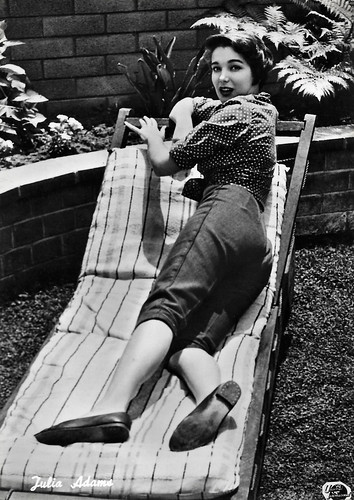
Julia Adams. Italian postcard by Bromofoto, Milano, no. 1210. Photo: Universal International.
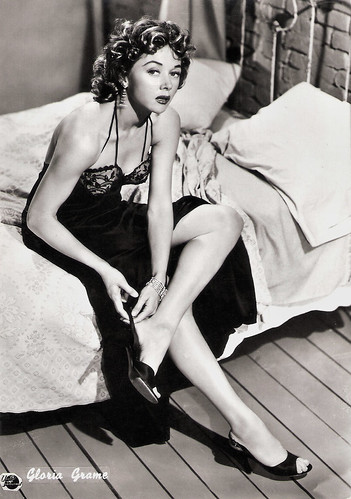
Gloria Grahame. Italian postcard by Bromofoto, Milano, no. 1190. Photo: Universal International. Publicity still for Naked Alibi (Jerry Hopper, 1954).

Maureen O'Hara. Dutch postcard, no. 198. Photo: Universal International. Publicity still for Lady Godiva of Coventry (Arthur Lubin, 1955).
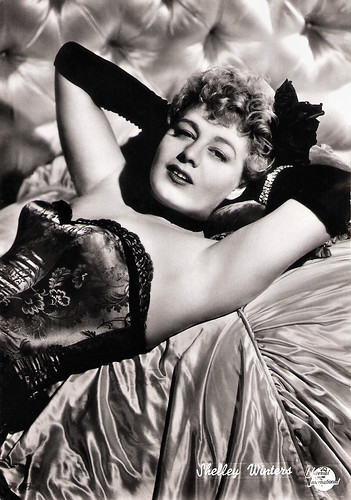
Shelley Winters. Italian postcard by Bromofoto, Milano, no. 316. Photo: Universal International.
By the late 1950s, the film business was again changing. The combination of the studio/theatre-chain break-up and the rise of television saw the reduced audience size for cinema productions. The Music Corporation of America (MCA), the world's largest talent agency, had also become a powerful television producer. Universal agreed to sell its studio lot to MCA in 1958. MCA dit not own Universal Pictures, yet was increasingly influential on Universal's product. The studio lot was upgraded and modernized, while MCA clients like Doris Day, Lana Turner, Cary Grant, and director Alfred Hitchcock were signed to Universal contracts. The long-awaited takeover of Universal Pictures by MCA, Inc. happened in mid-1962. The company reverted in name to Universal Pictures from Universal-International.
As a final gesture before leaving the talent agency business, virtually every MCA client was signed to a Universal contract. In 1964, MCA formed Universal City Studios, Inc., merging the motion pictures and television arms and thus Universal became a full-blown, A-film studio, with leading actors and directors under contract; offering slick, commercial films; and a studio tour subsidiary launched in 1964. Early film productions under MCA included The Birds (Alfred Hitchcock, 1962), which grossed $4.6 million, and To Kill a Mockingbird (Robert Mulligan, 1962), which won three Academy Awards, including Best Actor for Gregory Peck. Ross Hunter continued to be the company's most successful producer with Thoroughly Modern Millie (George Roy Hill, 1968) with Julie Andrews, followed by the all-star blockbuster Airport (George Seaton, 1970) with Burt Lancaster, which grossed $45.3 million. Airport originated the 1970s disaster film genre.
Hal B. Wallis, who had recently worked as a major producer at Paramount, moved over to Universal, where he produced several films, among them the lavish costume drama Anne of the Thousand Days (Charles Jarrott, 1969) which tells the story of Anne Boleyn, and the equally lavish Mary, Queen of Scots (Charles Jarrott, 1971), starring Vanessa Redgrave and Glenda Jackson. Although neither could claim to be a big financial hit, both films received Academy Award nominations, and Anne was nominated for Best Picture, Best Actor (Richard Burton), Best Actress (Geneviève Bujold), and Best Supporting Actor (Anthony Quayle). Wallis retired from Universal after making the Western Rooster Cogburn (Stuart Millar, 1975), a sequel to True Grit (Henry Hathaway, 1969), which Wallis had produced at Paramount. Rooster Cogburn co-starred John Wayne in his penultimate film, reprising his Oscar-winning role as U.S. Marshal Rooster Cogburn from the earlier film, and Katharine Hepburn. It would be their only film together. The film was only a moderate success.
In the early 1970s, Universal teamed up with Paramount to form Cinema International Corporation, which distributed films by Paramount and Universal outside of the US and Canada. Although Universal was primarily a television studio during the decade, it did produce occasional hits, among them the caper The Sting (George Roy Hill, 1973) starring Paul Newman and Robert Redford and winning seven Oscars, including Best Picture, Best Director and Best Original Screenplay, and the coming-of-age comedy American Graffiti (George Lucas, 1973). A huge box-office success which restored the company's fortunes was Jaws (Steven Spielberg, 1975) with Roy Scheider, Richard Dreyfuss and Robert Shaw. Considered one of the greatest films ever made, Jaws was the prototypical summer blockbuster, with its release regarded as a watershed moment in film history. It became the highest-grossing film of all time until the release of Star Wars (George Lucas, 1977). Both films were pivotal in establishing the modern Hollywood business model, which revolves around high box-office returns from action and adventure pictures with simple high-concept premises released during the summer in thousands of cinemas and heavily advertised.
During the 1980s Universal released several award-winning films. Coal Miner's Daughter (Michael Apted, 1980) grossed $38.5 million, and Sissy Spacek won an Oscar for Best Actress. On Golden Pond (Mark Rydell, 1981) grossed $63 million and won three of ten Academy Award nominations, including Best Actor for Henry Fonda and Best Actress for Katherine Hepburn. Meryl Streep won the Best Actress Oscar for Sophie's Choice (Alan J. Pakula, 1982). Sidney Pollack's production of Out of Africa (1985) won seven Academy Awards, including Best Picture and Best Director for Pollack.
CIC decided to merge UA's international units with MGM and reformed it as United International Pictures. There would be other film hits like E.T. the Extra-Terrestrial (Steven Spielberg, 1982), Back to the Future (Robert Zemeckis, 1985), An American Tail (Don Bluth, 1986), The Land Before Time (Don Bluth, 1988), and Jurassic Park (Steven Spielberg, 1993), but the film business was financially unpredictable. UIP began distributing films by start-up studio DreamWorks in 1997, due to connections the founders have with Paramount, Universal, and Amblin Entertainment.
Universal was involved in a series of acquisitions, and in 2004 the company (as part of Vivendi Universal Entertainment) merged with the National Broadcasting Co., Inc., to form NBC Universal. Recent blockbusters were the sequels Despicable Me 2 (Pierre Coffin, Chris Renaud, 2013), Furious 7 (James Wan, 2015) and Jurassic World (Colin Trevorrow, 2015).

Doris Day. Dutch postcard by Uitg. Takken, Utrecht, no. AX 4240. Photo: Universal International. Publicity still for Pillow Talk (Michael Gordon, 1959). Collection: Geoffrey Donaldson Institute.
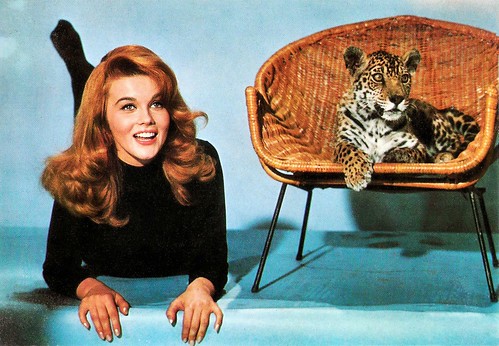
Ann Margret. Spanish postcard by Postal Oscarcolor, S.L., no. 27. Photo: Universal Pictures. Publicity still for Kitten with a Whip (Douglas Heyes, 1964).

Michael Parks. Vintage American collectors card. Photo: Universal / Pennebaker. Publicity still for Wild Seed ( Brian G. Hutton, 1965).
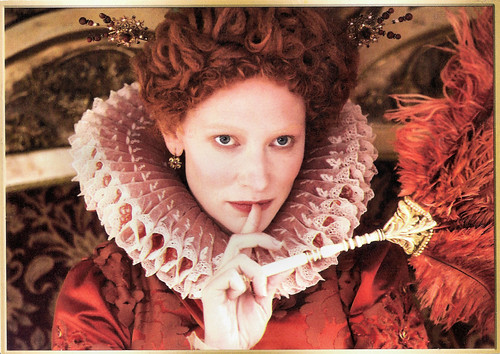
Cate Blanchett. German postcard by Universal Pictures.de for the DVD release. Photo: Universal. Publicity still for Elizabeth: the Golden Age (Shekhar Kapur, 2007).
Sources: Funding Universe, Encyclopaedia Britannica, Wikipedia and IMDb.

Deanna Durbin. Dutch postcard by Sparo (Gebr. Spanjersberg N.V., Rotterdam). Photo: Universal.

Maria Montez. Spanish postcard by Archivo Bermejo, Barcelona. Photo: Universal. Photo: publicity still for Sudan (John Rawlins, 1945).

Douglas Fairbanks Jr. American postcard by Universal. Photo: publicity still for The Exile (Max Ophüls, 1947).

Bud Abbott & Lou Castello. Dutch postcard, no. 950. Photo: Universal Film.

George Nader and Virginia Mayo. Spanish postcard by F.A.G., no. 440. Photo: Universal. Publicity still for Congo Crossing (Joseph Pevney, 1956).
Light musicals with young sopranos
Standard Capital's J. Cheever Cowdin had taken over as president and chairman of the board of directors, and instituted severe cuts in production budgets. Gone were the big ambitions, and though Universal had a few big names under contract, those it had been cultivating, like William Wyler and Margaret Sullavan, left.
Meanwhile, producer Joe Pasternak, who had been successfully producing light musicals with young sopranos for Universal's German subsidiary, repeated his formula in America. Teenage singer Deanna Durbin starred in Pasternak's first American film, Three Smart Girls (Henry Koster, 1936). The film was a box-office hit and reputedly resolved the studio's financial problems. It also began an eight-year era of successful Deanna Durbin musicals and spawned two sequels, Three Smart Girls Grow Up (Henry Koster, 1939) and Hers to Hold (Frank Ryan, 1943).
When Pasternak stopped producing Durbin's pictures, and she outgrew her screen persona and pursued more dramatic roles, the studio signed 13-year-old Gloria Jean for her own series of Pasternak musicals from 1939; she went on to star with Bing Crosby, and Donald O'Connor. Her best-known picture is her fourth, Never Give a Sucker an Even Break (Edward F. Cline, 1941), in which she co-starred with W. C. Fields.
A popular Universal film of the late 1930s was Destry Rides Again (George Marshall, 1939), starring James Stewart as Destry and Marlene Dietrich in her comeback role after leaving Paramount. The successful film was for Stewart and Dietrich their first Western, and especially the ferocious cat-fight between Marlene Dietrich and Una Merkel was memorable.
By the early 1940s, the company was concentrating on lower-budget productions that were the company's main staple: Westerns, melodramas, serials and sequels to the studio's horror pictures, the latter now solely B-pictures. The studio fostered many series: The Dead End Kids and Little Tough Guys action features and serials (1938–43); comedies with The Ritz Brothers (1940–43); and Westerns with Tom Mix (1932–1933), Buck Jones (1933–1936), and Johnny Mack Brown (1938–1943).
Universal could seldom afford its own stable of stars, and often borrowed talent from other studios, or hired freelance actors. In addition to Stewart and Dietrich, Margaret Sullavan, and Bing Crosby were two of the major names that made a couple of pictures for Universal during this period. Some stars came from radio, including Edgar Bergen, W. C. Fields, and the comedy team of Abbott and Costello (Bud Abbott and Lou Costello). Abbott and Costello's military comedy Buck Privates (Arthur Lubin, 1941) gave the former burlesque comedians a national and international profile. The film received two Academy Award nominations in 1941, and was one of the biggest money-makers of the year for Universal, grossing over $4 million at the box office. Japan used this film as propaganda to demonstrate to its own troops the 'incompetence' of the American Army.

Marlene Dietrich. French postcard by Editions P.I., Paris, no. 219, offered by Victoria, Brussels. Photo: Universal Pictures.

Yvonne De Carlo. French postcard by Editions P.I., Paris, no. 298. Photo: Universal.

Maria Montez and Jon Hall. Vintage card. Photo: Universal. Publicity still for White Savage (Arthur Lubin, 1943).

Burt Lancaster. British postcard in The People series by Show Parade Picture Service, London, no. P. 1038. Photo: Universal International.

Marta Toren. Vintage postcard, no. 505. Photo: Universal International.
Arabian Nights in Technicolor
During the war years Universal did have a co-production arrangement with producer Walter Wanger and his partner, director Fritz Lang, lending the studio some amount of prestige productions. Their Film Noir Scarlet Street (Fritz Lang, 1945) is now considered a central film in the genre. The screenplay concerns two criminals (Joan Bennett and Dan Duryea) who take advantage of a middle-age painter (Edward G. Robinson) in order to steal his artwork. Alfred Hitchcock was also borrowed for two films from Selznick International Pictures: the spy thriller Saboteur (Alfred Hitchcock, 1942) and the psychological thriller Shadow of a Doubt (Alfred Hitchcock, 1943) starring Teresa Wright and Joseph Cotten.
Universal's core audience base was still found in the neighbourhood cinemas, and the studio continued to please the public with low- to medium-budget films. Basil Rathbone and Nigel Bruce appeared in a new series of twelve films based on Sir Arthur Conan Doyle's Sherlock Holmes stories, and Universal made a series of teenage musicals with Gloria Jean, Donald O'Connor, and Peggy Ryan like What's Cookin'? (Edward F. Cline, 1942) and Get Hep to Love (Charles Lamont, 1942).
As Universal's main product had always been low-budget film, it was one of the last major studios to have a contract with Technicolor. The studio did not make use of the three-strip Technicolor process until Arabian Nights (John Rawlins, 1942), starring Sabu, Jon Hall and Maria Montez. The film is derived from The Book of One Thousand and One Nights but owes more to the imagination of Universal Pictures than the original Arabian stories. The film is one of series of 'exotic' tales released by Universal during the war years. In 1943, Technicolor was also used in Universal's remake of their 1925 horror melodrama, Phantom of the Opera (Arthur Lubin, 1943) with Claude Rains, Nelson Eddy and Susanna Foster. With the success of their first two colour pictures, a regular schedule of high-budget, Technicolor films followed.
While there were to be a few hits like The Killers (Robert Siodmak, 1946) starring Burt Lancaster in his film debut, and Ava Gardner, and the Film Noir The Naked City (Jules Dassin, 1948), Universal-International's new theatrical films often met with disappointing response at the box office. By the late 1940s, the ambitious head of production William Goetz was out, and the studio returned to low-budget and series films.
The inexpensive comedy Francis (Arthur Lubin, 1950), starring Donald O'Connor, Patricia Medina and Francis, the talking mule, was a hit. It lead to a series of six films about Francis, whose distinctive voice is a voice-over by actor Chill Wills. Another mainstay of the company was the Pa and Ma Kettle franchise which started with Ma and Pa Kettle (Charles Lamont, 1949), starring Marjorie Main and Percy Kilbride. Once again, the films of Abbott and Costello, including Abbott and Costello Meet Frankenstein (Charles Barton, 1948), were also among the studio's top-grossing productions.
In the 1950s, Universal-International resumed their series of Arabian Nights films, including The Prince Who Was a Thief (Rudolph Maté, 1951) with Tony Curtis in his first starring role. The studio also had a success with monster and science fiction films produced by William Alland, such as It Came from Outer Space (Jack Arnold, 1953), the first Science-Fiction horror film in the 3D process, and Creature from the Black Lagoon (Jack Arnold, 1954) with Richard Carlson and Julia Adams. Other successes were Magnificent Obsession (Douglas Sirk, 1954) with Jane Wyman and Rock Hudson, and other melodramas directed by Douglas Sirk and produced by Ross Hunter, the so-called 'King of the Weepies' Although for film critics they were not so well thought of on first release as they have since become. Hunter's production of Pillow Talk (1959), starring Rock Hudson and Doris Day, grossed $7.5 million and prompted a surge in the romantic comedy genre.
Among Universal-International's stable of stars were also Audie Murphy, Kirk Douglas, Maureen O'Hara, Charlton Heston, Jeff Chandler, and John Gavin. In 1950 MCA agent Lew Wasserman made a deal with Universal for his client James Stewart that would change the rules of the business. Wasserman's deal gave Stewart a share in the profits of three pictures in lieu of a large salary. When one of those films, Winchester '73 (Anthony Mann, 1950) starring Stewart and Shelley Winters, proved to be a hit, the arrangement would become the rule for many future productions at Universal, and eventually at other studios as well.

Tony Curtis. Dutch postcard by Uitg. Takken, no. 1578. Photo: Universal International. Publicity still for The Prince Who Was a Thief (Rudolph Maté, 1951).

Julia Adams. Italian postcard by Bromofoto, Milano, no. 1210. Photo: Universal International.

Gloria Grahame. Italian postcard by Bromofoto, Milano, no. 1190. Photo: Universal International. Publicity still for Naked Alibi (Jerry Hopper, 1954).

Maureen O'Hara. Dutch postcard, no. 198. Photo: Universal International. Publicity still for Lady Godiva of Coventry (Arthur Lubin, 1955).

Shelley Winters. Italian postcard by Bromofoto, Milano, no. 316. Photo: Universal International.
A full-blown, A-film studio, with leading actors and directors
By the late 1950s, the film business was again changing. The combination of the studio/theatre-chain break-up and the rise of television saw the reduced audience size for cinema productions. The Music Corporation of America (MCA), the world's largest talent agency, had also become a powerful television producer. Universal agreed to sell its studio lot to MCA in 1958. MCA dit not own Universal Pictures, yet was increasingly influential on Universal's product. The studio lot was upgraded and modernized, while MCA clients like Doris Day, Lana Turner, Cary Grant, and director Alfred Hitchcock were signed to Universal contracts. The long-awaited takeover of Universal Pictures by MCA, Inc. happened in mid-1962. The company reverted in name to Universal Pictures from Universal-International.
As a final gesture before leaving the talent agency business, virtually every MCA client was signed to a Universal contract. In 1964, MCA formed Universal City Studios, Inc., merging the motion pictures and television arms and thus Universal became a full-blown, A-film studio, with leading actors and directors under contract; offering slick, commercial films; and a studio tour subsidiary launched in 1964. Early film productions under MCA included The Birds (Alfred Hitchcock, 1962), which grossed $4.6 million, and To Kill a Mockingbird (Robert Mulligan, 1962), which won three Academy Awards, including Best Actor for Gregory Peck. Ross Hunter continued to be the company's most successful producer with Thoroughly Modern Millie (George Roy Hill, 1968) with Julie Andrews, followed by the all-star blockbuster Airport (George Seaton, 1970) with Burt Lancaster, which grossed $45.3 million. Airport originated the 1970s disaster film genre.
Hal B. Wallis, who had recently worked as a major producer at Paramount, moved over to Universal, where he produced several films, among them the lavish costume drama Anne of the Thousand Days (Charles Jarrott, 1969) which tells the story of Anne Boleyn, and the equally lavish Mary, Queen of Scots (Charles Jarrott, 1971), starring Vanessa Redgrave and Glenda Jackson. Although neither could claim to be a big financial hit, both films received Academy Award nominations, and Anne was nominated for Best Picture, Best Actor (Richard Burton), Best Actress (Geneviève Bujold), and Best Supporting Actor (Anthony Quayle). Wallis retired from Universal after making the Western Rooster Cogburn (Stuart Millar, 1975), a sequel to True Grit (Henry Hathaway, 1969), which Wallis had produced at Paramount. Rooster Cogburn co-starred John Wayne in his penultimate film, reprising his Oscar-winning role as U.S. Marshal Rooster Cogburn from the earlier film, and Katharine Hepburn. It would be their only film together. The film was only a moderate success.
In the early 1970s, Universal teamed up with Paramount to form Cinema International Corporation, which distributed films by Paramount and Universal outside of the US and Canada. Although Universal was primarily a television studio during the decade, it did produce occasional hits, among them the caper The Sting (George Roy Hill, 1973) starring Paul Newman and Robert Redford and winning seven Oscars, including Best Picture, Best Director and Best Original Screenplay, and the coming-of-age comedy American Graffiti (George Lucas, 1973). A huge box-office success which restored the company's fortunes was Jaws (Steven Spielberg, 1975) with Roy Scheider, Richard Dreyfuss and Robert Shaw. Considered one of the greatest films ever made, Jaws was the prototypical summer blockbuster, with its release regarded as a watershed moment in film history. It became the highest-grossing film of all time until the release of Star Wars (George Lucas, 1977). Both films were pivotal in establishing the modern Hollywood business model, which revolves around high box-office returns from action and adventure pictures with simple high-concept premises released during the summer in thousands of cinemas and heavily advertised.
During the 1980s Universal released several award-winning films. Coal Miner's Daughter (Michael Apted, 1980) grossed $38.5 million, and Sissy Spacek won an Oscar for Best Actress. On Golden Pond (Mark Rydell, 1981) grossed $63 million and won three of ten Academy Award nominations, including Best Actor for Henry Fonda and Best Actress for Katherine Hepburn. Meryl Streep won the Best Actress Oscar for Sophie's Choice (Alan J. Pakula, 1982). Sidney Pollack's production of Out of Africa (1985) won seven Academy Awards, including Best Picture and Best Director for Pollack.
CIC decided to merge UA's international units with MGM and reformed it as United International Pictures. There would be other film hits like E.T. the Extra-Terrestrial (Steven Spielberg, 1982), Back to the Future (Robert Zemeckis, 1985), An American Tail (Don Bluth, 1986), The Land Before Time (Don Bluth, 1988), and Jurassic Park (Steven Spielberg, 1993), but the film business was financially unpredictable. UIP began distributing films by start-up studio DreamWorks in 1997, due to connections the founders have with Paramount, Universal, and Amblin Entertainment.
Universal was involved in a series of acquisitions, and in 2004 the company (as part of Vivendi Universal Entertainment) merged with the National Broadcasting Co., Inc., to form NBC Universal. Recent blockbusters were the sequels Despicable Me 2 (Pierre Coffin, Chris Renaud, 2013), Furious 7 (James Wan, 2015) and Jurassic World (Colin Trevorrow, 2015).

Doris Day. Dutch postcard by Uitg. Takken, Utrecht, no. AX 4240. Photo: Universal International. Publicity still for Pillow Talk (Michael Gordon, 1959). Collection: Geoffrey Donaldson Institute.

Ann Margret. Spanish postcard by Postal Oscarcolor, S.L., no. 27. Photo: Universal Pictures. Publicity still for Kitten with a Whip (Douglas Heyes, 1964).

Michael Parks. Vintage American collectors card. Photo: Universal / Pennebaker. Publicity still for Wild Seed ( Brian G. Hutton, 1965).

Cate Blanchett. German postcard by Universal Pictures.de for the DVD release. Photo: Universal. Publicity still for Elizabeth: the Golden Age (Shekhar Kapur, 2007).
Sources: Funding Universe, Encyclopaedia Britannica, Wikipedia and IMDb.
No comments:
Post a Comment